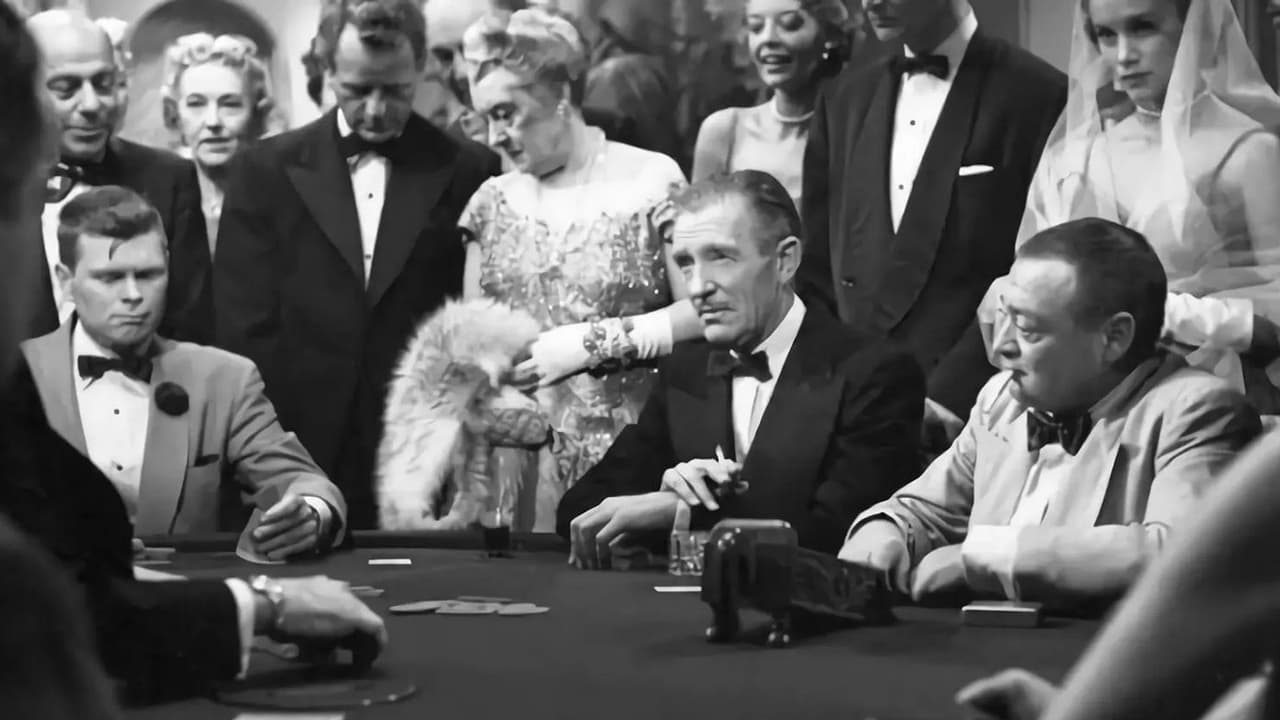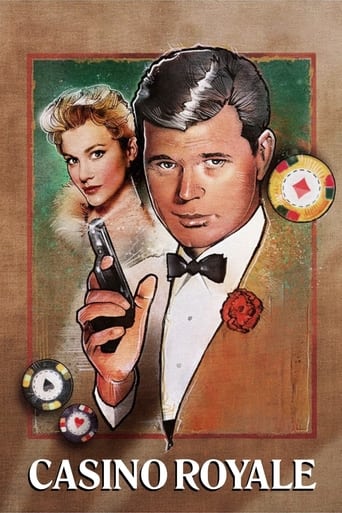

one of my absolute favorites!
... View MoreIt’s an especially fun movie from a director and cast who are clearly having a good time allowing themselves to let loose.
... View MoreThe movie's neither hopeful in contrived ways, nor hopeless in different contrived ways. Somehow it manages to be wonderful
... View MoreOne of the film's great tricks is that, for a time, you think it will go down a rabbit hole of unrealistic glorification.
... View MoreEarly TV movie adaptation of 'Casino Royale' has the low key feeling of the original novel. The low budget both helps the movie and hinders it: it gives it the grittier look that some of the Bond novels have, and also makes it look slightly like a film noir, but also limits it in term of sets and props and lighting (which is often times visible over the actors' heads.) The short run time is also a mixed bag: the film doesn't overstay its welcome, and follows the book fairly closely, (the original novel was so short that it seems almost like a pamphlet, rather than a full length novel) but it doesn't give much opportunity to flesh out the characters at all.Peter Lorre is good as LeChiffre, and Michael Pate as Leiter (or "Letter" as he's listed in the end credits) is very likable, and perhaps would have made a better choice to play Bond here, but Barry Nelson was mediocre. If he would have been more familiar with the character and not been doing a Humphrey Bogart impersonation, he might have been good. He does fairly well when he's intensely grilling Valerie Mathis about the microphone LeChiffre planted in Bond's room, and he's adequate in the casino sequences, but falls flat during the climactic scenes.This TV-movie is also marred by the fact that the love interest between Bond and the lead girl is almost completely overlooked here, as is Bond's contemplation of resignation and his subsequent double-cross by the girl; basically the entire fourth(!) act of the novel was omitted here. Maybe if it would have had a longer running time, and if the censors would have allowed it, they could have fleshed out some of these omitted story elements? One of the villain's henchmen has a cane which doubles as a gun, which is a good touch; this particular scene follows the book closely, and is one of the better scenes in this film.
... View MoreI don't think it was until the internet era that I found out an obscure trivia fact and that was the first media appearance of Ian Fleming's James Bond wasn't Sean Connery in DR NO but Barry Nelson in an American anthology series called CLIMAX which adapted CASINO ROYALE . We all know Bond is the most successful film franchise in history and we all recognise the icons , the babes , the exotic locations , the gadgets , the big set piece stunts etc of a franchise featuring a very British fictional hero . Now imagine a James Bond story without any of these icons . Worse than that imagine if he was an American character ? I do apologise I didn't mean to make you faint Some people have said this live American TV production deserves some credit for at least sticking to the plot of the original novel which is not something you can say about the films that started going their own way even before the end of the 1960s . My own fascination watching this was entirely down to the opposite reason - it's Bond as film noir that shares nothing in common with the film series . Bond played by Nelson wears a tuxedo and smokes too much but that's the only link you'll recognise . Surviving a murder attempt in the opening scene a policeman refers to it by stating:" They weren't after your winnings then ? " " Yeah ? They weren't after my autograph either " And that's the closest we get to show stopping one liners as the entire action takes place in a couple of sets shot in a TV studio as Jimmy tries to beat Peter Lorre's villain in a card gameOn its own this obscure TV drama come thriller would be totally forgotten if it wasn't for the fact that it's the first on screen appearance of someone playing Ian Fleming's James Bond . In comparison you can see why Bond became an instant legend in the 1960s with the exotic location filming and the sexy and charismatic Sean Connery playing the role with a hard edge . Not to be too dismissive of the 1954 version of CASINO ROYALE it's fascinating to see Bond done as essentially film noir
... View MoreYou need to know this first: In the old days TV didn't count count much for quality and any critique would not have shot down a novel that anything was based on. This Bond movie was VERY fortunately placed on TV, because as a regular theater release it would have absolutely killed the entire Bond franchise, no questions asked ever after. We would have never enjoyed the funny, tongue in cheek, and very stylish Bond movies we got to know with Connery and Moore in the lead, if this had been in theaters, instead of TV, which nobody took serious back then! The acting of the main "Bond" character was lousy. No, it was worse than lousy, and the thing that makes Bond special, his British manners and tongue, were completely butchered by the urge to do it the "American Way". No style, no finesse. Early on, Bond is leaning against the Casino Royale entrance, smoking a cigarette in a completely exaggerated and outright ridiculous "cool" fashion, and it gets worse from there. As a children's theater production, this would have caused parents to applaud, but for grown ups, this is sheer embarrassment! I have to give it historic significance though, and for any serious fan, it will be a MUST watch. In contrast, you have to appreciate, what Broccoli Productions managed to squeeze out of a set of novels, that could have easily gone sour, just as the "Perry Rhodan" series (world's biggest and longest running SciFi franchise of novels ever - what, you didn't know?) did later on.I never finished this original 1954 Casino Royale when it ran on TNT many years ago, because it was SO bad, that it was not even the least bit good.Put it this way: If you are an international SciFi buff, you will know about the German "Perry Rhodan" series of novels that has been published weekly (yes, EVERY week!) since 1961 and is still running without interruption and is not known in the US at all, because of it's lousy debut as an Italian "spaghetti SciFi movie". With over two and a half thousand novels spinning a grand saga of the universe in the same series, it is the worlds longest running and most successful SciFi movie failure ever! Why? Because they released their el-cheapo cheesy movie in theaters back in the 1960's and never recovered from that failure. Look for "Mission Stardust", watch it, and know why the entire series failed to be filmed ever after!This Bond movie is just as bad, and actually worse, and if it had been in theaters, nobody in the movie world would ever have known Bond, period! If you like pain, watch it! If you are a serious fan of Bond, this is a MUST for education and cultural knowledge.Otherwise, save the pain and watch something else... like the "Flint" movies, which did it the American way, but with every bit of style to be expected from Bond, and of course the Broccoli Bond movies with Sean Connery, George Lazenby, Roger Moore, and Timothy Dalton :)
... View MoreThis very first Bond movie was made with no preconceptions about Bond and not much respect for Fleming's novels, which is why the story is in some ways badly butchered. The ending is dull and plain compared to the exciting double endings of the original story. Some scenes, like the opening assassination attempt, are clumsy, badly acted.Of course, making Bond American and Leiter English seems awfully stupid for us, but this was made for a pure American audience, so they just translated the story from a British spy story to an American one. Doing that in the 50's is more excusable than making Bond look like an eastern Europe gangster in the 2000's.A particularly interesting comparison between this and the 2006 movie is Le Chiffre. Is it possible that Mikkelsen was chosen simply because he looks very much like Peter Lorre? The similarity is striking. Mikkelsen is taller and slimmer, but put their portraits side by side and they almost look like the same person. And in both movies, they carry the best part. Both stand out as the character actor of the movie!All in all, I claim that a good Casino Royale movie is still to be made, one that takes the original story seriously and does it well. The 1967 version is by far worst, but all three are embarrassing. This one is just the least embarrassing of the three.
... View More